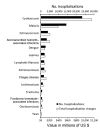Hospitalization frequency and charges for neurocysticercosis, United States, 2003-2012
- PMID: 25988221
- PMCID: PMC4451927
- DOI: 10.3201/eid2106.141324
Hospitalization frequency and charges for neurocysticercosis, United States, 2003-2012
Abstract
Neurocysticercosis, brain infection with Taenia solium larval cysts, causes substantial neurologic illness around the world. To assess the effect of neurocysticercosis in the United States, we reviewed hospitalization discharge data in the Nationwide Inpatient Sample for 2003-2012 and found an estimated 18,584 hospitalizations for neurocysticercosis and associated hospital charges totaling >US $908 million. The risk for hospitalization was highest among Hispanics (2.5/100,000 population), a rate 35 times higher than that for the non-Hispanic white population. Nearly three-quarters of all hospitalized patients with neurocysticercosis were Hispanic. Male sex and age 20-44 years also incurred increased risk. In addition, hospitalizations and associated charges related to cysticercosis far exceeded those for malaria and were greater than for those for all other neglected tropical diseases combined. Neurocysticercosis is an increasing public health concern in the United States, especially among Hispanics, and costs the US health care system a substantial amount of money.
Keywords: Neurocysticercosis; Taenia solium; brain disease; central nervous system diseases; cestode infection; cysticercosis; economic burden; epilepsy; helminthiasis; neglected tropical disease; parasites; parasitic disease.
Figures


References
Publication types
MeSH terms
LinkOut - more resources
Full Text Sources
Other Literature Sources

